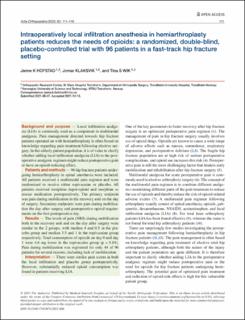| dc.contributor.author | Hofstad, Janne Kristin | |
| dc.contributor.author | Klaksvik, Jomar | |
| dc.contributor.author | Wik, Tina Strømdal | |
| dc.date.accessioned | 2023-01-26T14:34:32Z | |
| dc.date.available | 2023-01-26T14:34:32Z | |
| dc.date.created | 2022-08-24T09:03:23Z | |
| dc.date.issued | 2022 | |
| dc.identifier.citation | Acta Orthopaedica. 2022, 93 111-116. | en_US |
| dc.identifier.issn | 1745-3674 | |
| dc.identifier.uri | https://hdl.handle.net/11250/3046654 | |
| dc.description.abstract | Background and purpose — Local infiltration analgesia (LIA) is commonly used as a component in multimodal analgesia. Pain management directed towards hip fracture patients operated on with hemiarthroplasty is often based on knowledge regarding pain treatment following elective surgery. In this elderly patient population, it is of value to clarify whether adding local infiltration analgesia (LIA) to the postoperative analgesic regimen might reduce postoperative pain or have an opioid-reducing effect.
Patients and methods — 96 hip fracture patients undergoing hemiarthroplasty in spinal anesthesia were included. All patients received a multimodal pain regimen and were randomized to receive either ropivacaine or placebo. All patients received morphine depot-opioid and morphine as rescue medication postoperatively. The primary endpoint was pain during mobilization in the recovery unit on the day of surgery. Secondary endpoints were pain during mobilization the day after surgery and postoperative opioid requirements on the first postoperative day.
Results — The levels of pain (NRS) during mobilization both in the recovery unit and on the day after surgery were similar in the 2 groups, with median 4 and 0.5 in the placebo group and median 3.5 and 1 in the ropivacaine group respectively. Total consumption of opioids on day 0 and day 1 were 4.6 mg lower in the ropivacaine group (p = 0.04). Pain during mobilization was registered for only 44 of 96 patients for several reasons, including lack of mobilization.
Interpretation — There were similar pain scores in both the local infiltration and placebo group postoperatively. However, substantially reduced opioid consumption was found in patients receiving LIA. | en_US |
| dc.language.iso | eng | en_US |
| dc.publisher | Medical Journals Sweden AB | en_US |
| dc.rights | Navngivelse-Ikkekommersiell 4.0 Internasjonal | * |
| dc.rights.uri | http://creativecommons.org/licenses/by-nc/4.0/deed.no | * |
| dc.title | Intraoperatively local infiltration anesthesia in hemiarthroplasty patients reduces the needs of opioids: a randomized, double-blind, placebo-controlled trial with 96 patients in a fast-track hip fracture setting | en_US |
| dc.title.alternative | Intraoperatively local infiltration anesthesia in hemiarthroplasty patients reduces the needs of opioids: a randomized, double-blind, placebo-controlled trial with 96 patients in a fast-track hip fracture setting | en_US |
| dc.type | Peer reviewed | en_US |
| dc.type | Journal article | en_US |
| dc.description.version | publishedVersion | en_US |
| dc.source.pagenumber | 111-116 | en_US |
| dc.source.volume | 93 | en_US |
| dc.source.journal | Acta Orthopaedica | en_US |
| dc.identifier.doi | 10.2340/17453674.2021.806 | |
| dc.identifier.cristin | 2045527 | |
| cristin.ispublished | true | |
| cristin.fulltext | original | |
| cristin.qualitycode | 1 | |

